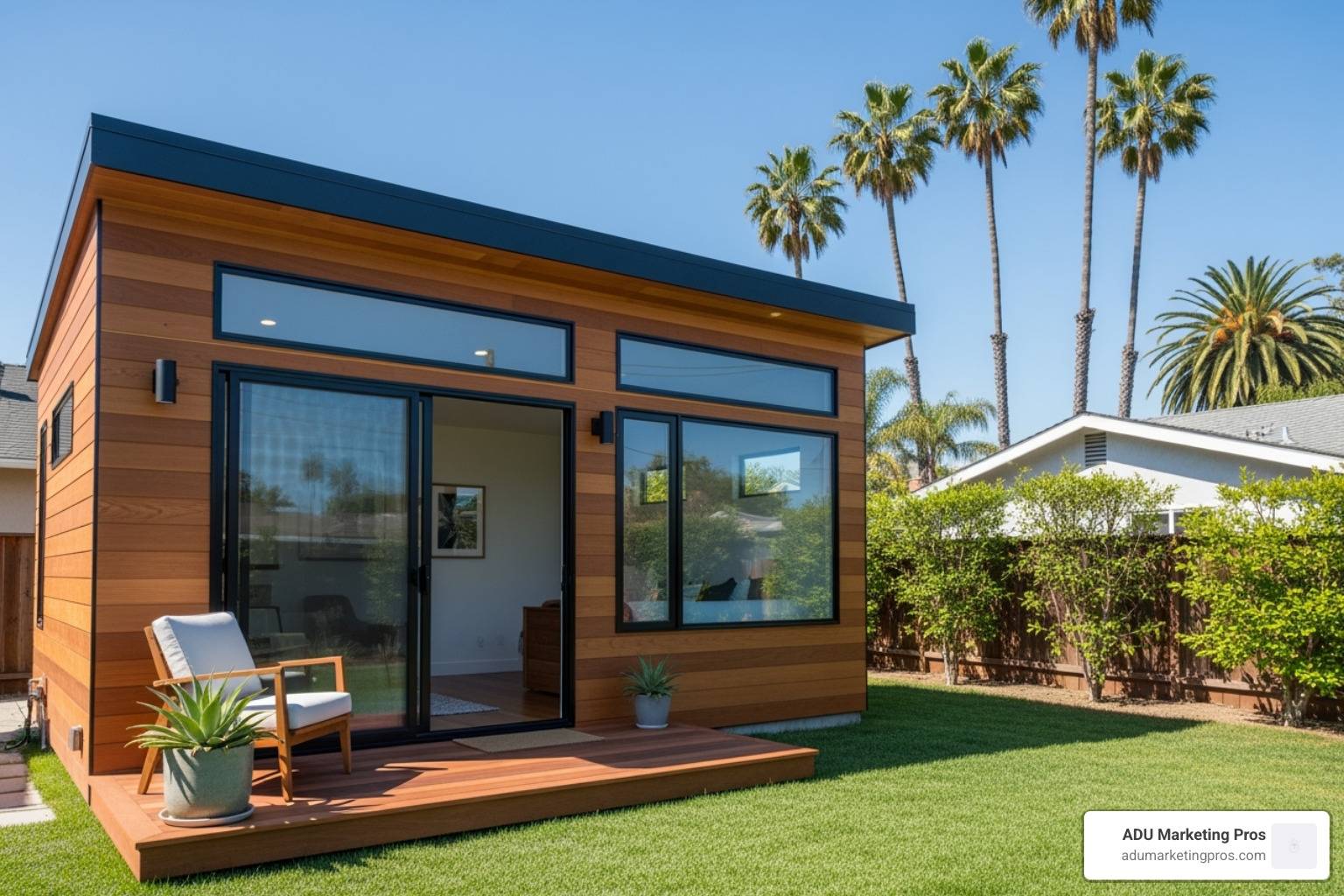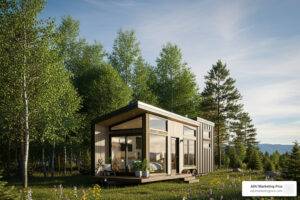Why California Homeowners Are Turning to Prefab ADUs
In the face of California’s persistent housing crisis, marked by soaring property values and a critical shortage of available homes, homeowners are increasingly looking for innovative solutions. Prefabricated accessory dwelling units (ADUs) have emerged as a powerful answer, offering a faster, more predictable, and less disruptive path to adding a second home to a property.
The prefab ADU California cost for a complete, turnkey installation typically ranges from $190,000 to over $450,000. The final investment is shaped by the ADU’s size, the specific city or county you live in, the complexity of your lot, and the level of finishes you choose.
Quick Cost Breakdown (All-In Estimates):
- Studio (approx. 350 sq ft): $190,000 – $304,000
- 1-bedroom (320-600 sq ft): $219,000 – $320,000
- 2-bedroom (567-800 sq ft): $290,000 – $437,000
- Large 2-bedroom (864-1,000 sq ft): $343,000 – $410,000
These factory-built homes can be installed up to 50% faster than their traditional, site-built counterparts. This remarkable speed is achieved by overlapping the project timelines: while your property is being graded and the foundation is being poured (site work), your ADU is simultaneously being constructed in a climate-controlled factory. This parallel process eliminates weather delays, streamlines inspections, and minimizes material waste, leading to a significantly compressed construction schedule.
While the speed is a primary draw, it’s crucial to understand that the final cost often aligns with traditional construction. The advertised “base price” from a manufacturer is only the starting point. Essential expenses like transportation, crane rental, permits, foundation work, and utility connections can easily add $50,000 to $100,000 or more to the total project budget. This guide is designed to explain every cost component, helping you budget accurately and avoid financial surprises on your journey to building an ADU.
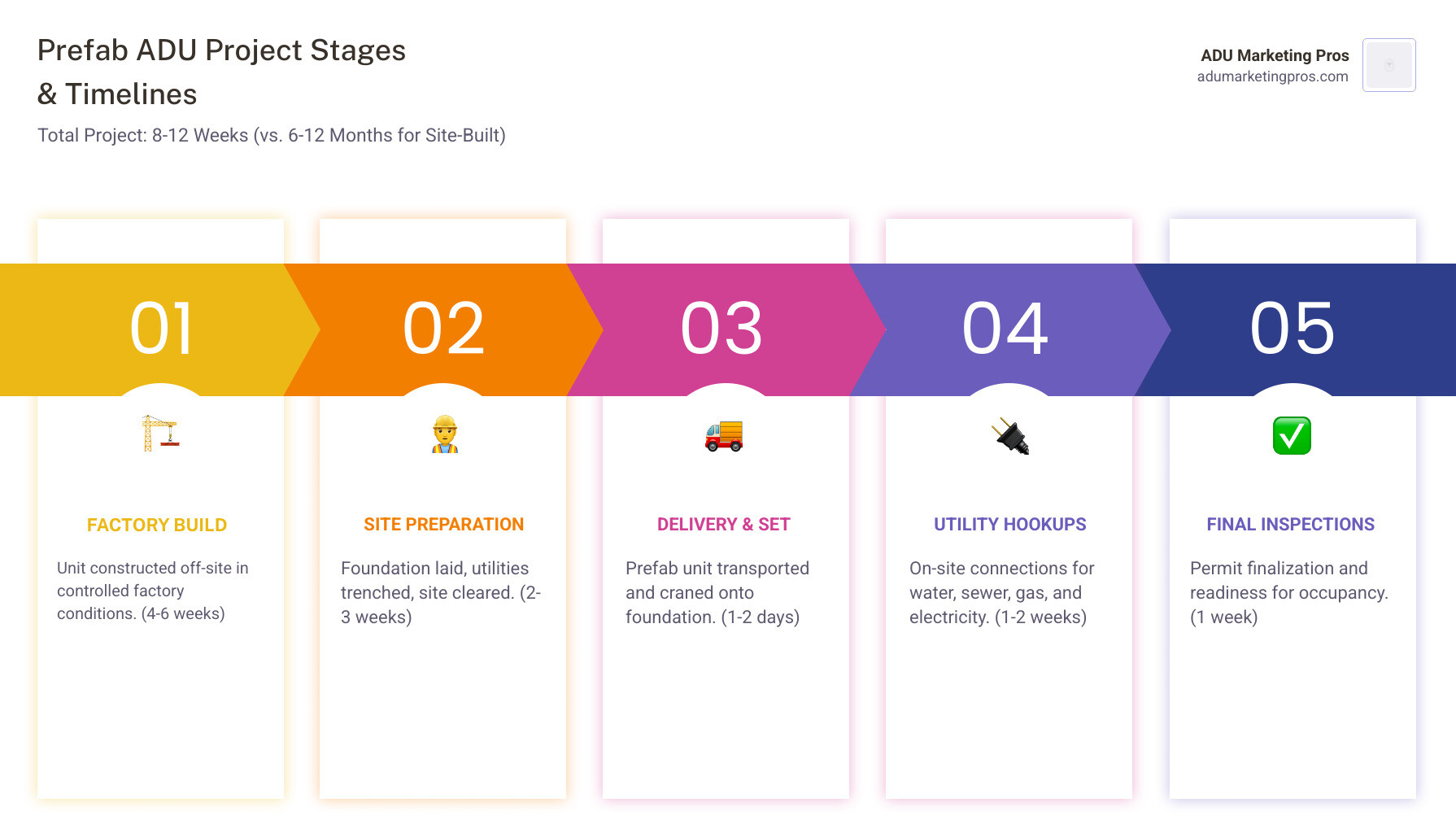
Terms related to prefab adu california cost:
Deconstructing the Prefab ADU California Cost: From Sticker Price to All-In Investment
When researching the prefab ADU California cost, it’s crucial to look beyond the attractive “base price” advertised by manufacturers. The true cost is the “all-in” investment, which includes everything from the unit itself to site work, permits, and installation. Understanding the total project budget is key to avoiding surprises.
The cost per square foot for an ADU varies significantly across California, driven by local labor rates, material costs, and the complexity of building codes. In the Bay Area (e.g., San Jose, Oakland), all-in costs can range from $400 to over $800 per square foot. In Southern California, Los Angeles averages $150,000 to $375,000 for a complete project, while San Diego trends slightly higher at around $210,000 and up. Even in more affordable areas like the Central Valley, homeowners should budget for significant site preparation and utility connection costs. These figures underscore how much location impacts your final budget.
For a deeper dive into the overall expenses, see our guide on More info about ADU Construction Cost.
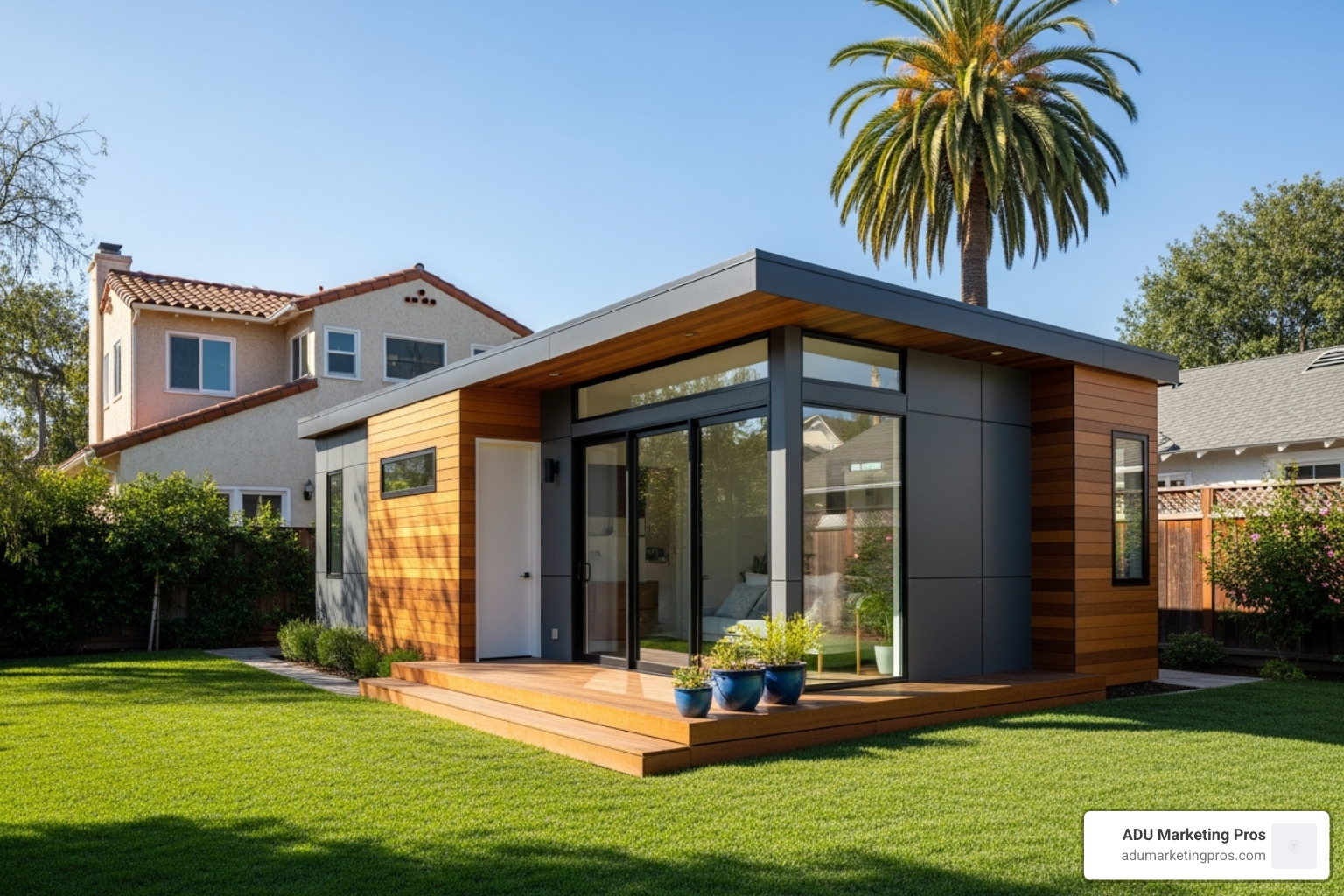
Average Prefab ADU California Cost by Size and Region
The size of your ADU is a primary cost driver. While larger units have a higher total price, the cost per square foot often decreases as fixed costs (like design, permits, and utility connections) are spread over more square footage.
Here’s a breakdown of typical all-in costs:
- Studio ADUs (approx. 350 sq ft): These compact units are the most affordable, with installed costs from $190,000 to $304,000.
- 1-Bedroom ADUs (320-600 sq ft): A step up in size, these units typically have installed costs between $219,000 and $320,000.
- 2-Bedroom ADUs (567-800 sq ft): Popular for rental income or families, these have installed costs from $290,000 to $437,000.
- Large 2-Bedroom ADUs (864-1,000 sq ft): For maximum space, expect costs between $343,000 and $410,000 for a full installation.
It’s vital to distinguish the unit’s purchase price ($50,000 – $250,000) from the all-in cost. The purchase price is for the factory-built structure only and excludes necessary site work, permits, and installation. For example, some all-inclusive prefab models average $345-$405+ per square foot once all project expenses are factored in.
For more detailed insights into general ADU costs, visit our page on More info about Accessory Dwelling Unit Costs.
Prefab vs. Site-Built: A Cost and Timeline Comparison
Many homeowners choose prefab ADUs for their speed and efficiency, though the final prefab ADU California cost often converges with that of a site-built unit. The main advantages of prefab include:
- Factory Efficiency: Building in a controlled environment reduces material waste, prevents weather-related delays, and allows for bulk purchasing of materials.
- Timeline Advantages: Prefab ADUs can be installed in weeks once the site is ready, compared to 6-12 months for site-built projects. This is possible because factory construction and site preparation happen simultaneously.
- Minimal Site Disruption: With the unit arriving nearly complete, the on-site construction period is short, reducing noise, dust, and disruption to your daily life.
- Customization: While less flexible than site-built homes, many prefab companies offer a range of customization options for finishes, fixtures, and layouts.
Despite these benefits, the all-in cost is often similar because both project types require the same site preparation, foundation, utility connections, and permits. Prefabs also have added costs for transportation and crane placement.
| Feature | Prefab ADU | Site-Built ADU |
|---|---|---|
| Total Cost | Often comparable to site-built once all “hidden” costs are factored in. | Can be similar to prefab, depending on complexity and finishes. |
| Construction Timeline | Faster (8-16 weeks total project time). | Slower (6-12 months or more). |
| On-Site Disruption | Minimal (weeks of on-site work). | Significant (months of on-site work). |
| Design Flexibility | Moderate (customization within pre-engineered limits). | High (fully customizable to unique specifications). |
| Cost Predictability | High (fixed factory price reduces risk of overruns). | Moderate (vulnerable to on-site surprises and change orders). |
| Quality Control | High (built in a controlled factory setting). | Variable (depends heavily on the on-site contractor). |
How Site Conditions Affect Your Prefab ADU California Cost
Your property’s unique traits can significantly impact the final prefab ADU California cost. Key factors include:
- Lot Accessibility: Difficult access for large trucks and cranes can increase costs for special equipment, traffic control, or manual labor.
- Sloped vs. Flat Lots: Sloped lots require more extensive grading, excavation, and complex foundations (like stepped or cantilevered designs), increasing costs substantially.
- Soil Quality & Seismic Needs: Poor soil may require specialized engineering or deeper foundations. California’s seismic requirements often mandate robust foundation engineering to ensure safety, adding to the budget.
- Demolition & Tree Removal: Removing existing structures, concrete patios, or large trees will add to your project costs.
- Foundation Needs: All ADUs need a permanent foundation. A concrete slab-on-grade is common for flat lots, while a raised perimeter or pier foundation may be needed for slopes. Costs vary based on soil, slope, and local codes.
- Utility Trenching Distance: The farther your ADU is from the main utility lines (water, sewer/septic, electricity), the more expensive it will be to dig trenches and run connections. Costs can range from $100 to $300 per linear foot.
To get a more precise estimate custom to your specific property, use our More info about our ADU Cost Calculator.
Beyond the Base Price: Uncovering the “Hidden” Costs of a Prefab ADU
The advertised base price of a prefab unit is just the beginning. The total prefab ADU California cost can easily double once essential “hidden” expenses are included. These costs fall into two main categories: “soft costs” (planning, design, permits) and “hard costs” (physical construction, site work). Budgeting for them is critical to avoid surprises.
For more insights on keeping your ADU project affordable, check out our guide on More info about Affordable ADU California.

Pre-Construction and Permitting Fees (Soft Costs)
Before any ground is broken, you’ll encounter several pre-construction and permitting fees. These can total $15,000 to $40,000 or more.
- Design and Engineering Fees: Even with pre-designed plans, you’ll need a site plan and structural engineering for the foundation. These fees can represent 10-15% of the total project cost.
- Geotechnical / Soils Report: Many jurisdictions, especially on hillsides or in areas with expansive soil, require a report from a geotechnical engineer to inform foundation design. This can cost $2,000 to $5,000.
- Title 24 Energy Reports: California requires a detailed report to ensure your ADU meets its strict energy efficiency standards.
- City/County Permit Fees: Permit costs vary widely by location but can range from $2,000 to over $10,000. In some high-cost areas, total fees and taxes can approach $20,000.
- Plan Check Fees: Your local planning department charges a fee to review your plans for compliance with zoning and building codes.
- Impact Fees: State law waives impact fees (for things like parks, traffic, and schools) for ADUs under 750 square feet. For larger ADUs, cities may charge a prorated fee based on the size of the ADU relative to the primary home.
For official guidance, refer to the California Department of Housing and Community Development (HCD), which oversees state ADU laws.
Site Preparation and Utility Infrastructure (Hard Costs)
Once permits are approved, the physical “hard costs” of preparing your property begin. These can range from $20,000 to $75,000+.
- Grading and Excavation: Leveling the site for the foundation is a necessary first step, with costs varying based on your lot’s slope and soil type.
- Foundation Installation: A prefab unit requires a solid foundation. A concrete slab can cost $10,000-$20,000, while more complex foundations for sloped lots can exceed $30,000.
- Utility Hookups: Connecting water, sewer, electricity, and gas is critical. Costs increase significantly with the distance from existing lines. A new sewer connection alone can cost $5,000 to $25,000.
- Electrical Panel Upgrades: Many older homes need their main electrical panel upgraded to handle the ADU’s additional load, a cost of $2,500 to $5,000.
- Trenching Costs: Digging trenches for utility lines is a major expense, influenced by distance, depth, and soil conditions. Expect costs of $100-$300 per linear foot.
Understanding California’s specific ADU regulations can help you anticipate some of these costs. Learn more at More info about California ADU Regulations.
Delivery, Installation, and Finishing
The final stages involve getting the unit to your property and making it move-in ready. These costs can add $20,000 to $60,000 or more.
- Transportation and Delivery Fees: Moving an oversized ADU module requires special permits, pilot cars, and logistical planning, adding several thousand dollars to the cost.
- Crane Rental Costs: A crane is often needed to lift the ADU over your home and onto the foundation. Depending on the size and reach required, this can cost $4,000 to $15,000 for the day.
- On-Site Assembly Labor (“Stitching”): Workers are needed to connect modules, seal seams, and finish the installation. General installation labor can cost $10,000 to $30,000.
- Exterior and Interior Finishes: This includes siding, roofing, flooring, paint, cabinetry, and fixtures. While some finishes are standard, upgrades will increase the cost. Materials can account for 45-50% of the total project cost.
- Appliances: The cost of refrigerators, stoves, washers, and dryers must be factored into your budget.
- Landscaping, Decks, and Hardscaping: Decks, patios, and walkways help integrate the ADU into your property but add to the final price.
- Contingency Fund: It is essential to set aside a contingency fund of 10-15% of the total project cost to cover unexpected issues, such as hitting rock during excavation or unforeseen utility complications.
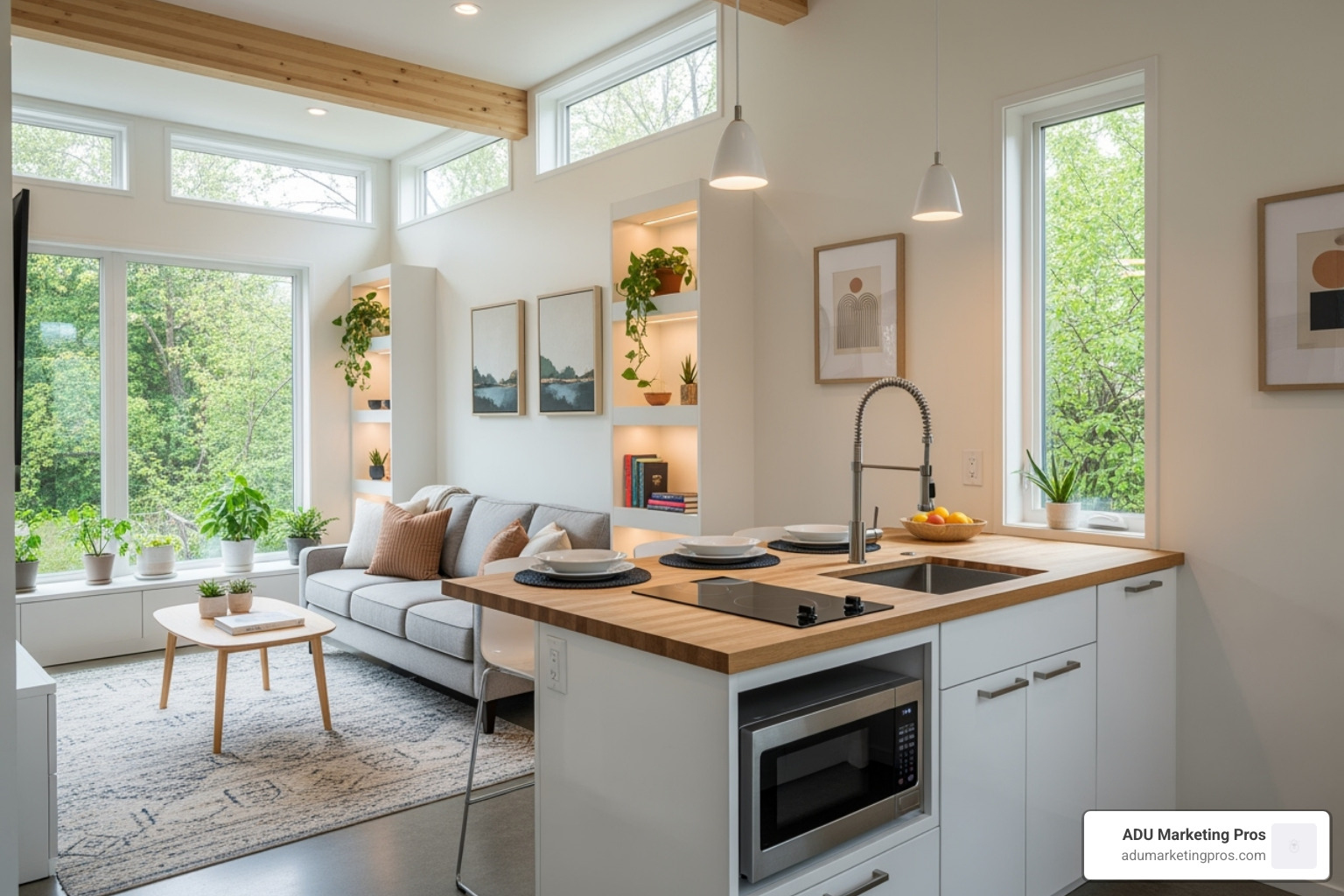
Navigating the Process: Financing and Permitting Your California ADU
A successful ADU project requires careful planning and management, especially when it comes to financing and permitting. Understanding this step-by-step process will save you time, money, and stress, ensuring your investment is sound and your project runs smoothly.
For those considering a compact living solution, our insights on More info about Prefab Granny Flat California can be quite helpful.

The California ADU Permitting Process Explained
California has passed numerous laws to streamline ADU regulations, making it easier for homeowners to build. State laws prevent cities from imposing overly restrictive rules, but local jurisdictions maintain control over specific requirements for setbacks, height, and design aesthetics.
- Plan Submission & Review: Your complete set of plans is submitted to the local planning and building department. A key state-mandated reform is the 60-day “shot clock,” which requires cities to approve or deny a complete ADU application within 60 days. Using a prefab company’s pre-approved plans can sometimes speed this up, though a site-specific plan is always required.
- Inspections: During construction, city or county inspectors will visit your property at key milestones (e.g., foundation, framing, plumbing, electrical) to ensure the work complies with building codes. A final inspection is required before a Certificate of Occupancy is issued, allowing the unit to be legally inhabited.
- Property Taxes: A permitted ADU will increase your property’s assessed value, leading to higher property taxes. However, it does not trigger a reassessment of your entire property. Instead, California uses a “blended assessment.” Your existing home remains taxed at its original value (under Prop 13), and only the value of the new ADU is added to your tax bill. This increase is often easily offset by the added home value and potential rental income.
Common documents needed for an ADU permit application include:
- Site Plan: Shows property lines, existing structures, the proposed ADU location, setbacks, and utility connections.
- Floor Plans and Elevations: Detailed drawings of the ADU’s layout and exterior appearance.
- Foundation Plan: Engineered plan for the ADU’s foundation.
- Structural Calculations: Engineering details to prove the structure’s stability.
- Title 24 Energy Report: Proves compliance with California’s energy code.
- Utility Connection Plans: Shows how the ADU will connect to water, sewer, and power.
- Geotechnical Report: May be required by the city for certain site conditions.
- HOA Approval: If applicable, a letter from your HOA approving the project.
Financing Your Prefab ADU Project
Several financing options are available to help California homeowners fund their ADU project. The best choice depends on your financial situation, home equity, and project timeline.
- Home Equity Line of Credit (HELOC): Pro: A flexible line of credit you can draw from as needed, ideal for managing variable construction costs. Con: Interest rates are typically variable and can rise over time.
- Home Equity Loans: Pro: A lump-sum loan with a fixed interest rate, providing predictable monthly payments. Con: Less flexible if unexpected costs arise.
- Cash-Out Refinance: Pro: Replaces your current mortgage with a new, larger one, often securing a low interest rate for the entire amount. Con: Involves closing costs and resets your mortgage term.
- Construction Loans: Pro: Specifically designed for building projects, with funds disbursed in stages as work is completed. Con: Can have a more complex application process and higher interest rates than other options.
- Renovation Loans: Programs like the FHA 203(k) or Fannie Mae HomeStyle loan base the loan amount on the property’s future value after the ADU is built, which can help you qualify for a larger loan.
- California ADU Grant Programs: The CalHFA ADU Grant Program offers up to $40,000 for pre-development and non-recurring closing costs. This grant is aimed at low- and moderate-income homeowners and can significantly reduce the initial financial barrier. Learn more at the Information on the CalHFA ADU Grant Program.
For a comprehensive look at your options, explore our guide on More info about ADU Financing Options.
Is a Prefab ADU the Right Investment for You?
After breaking down the prefab ADU California cost, is it the right move for you? For many California homeowners, the answer is a resounding yes. An ADU is a major investment that adds a complete, independent living unit to your property, bringing both powerful financial returns and significant lifestyle benefits.
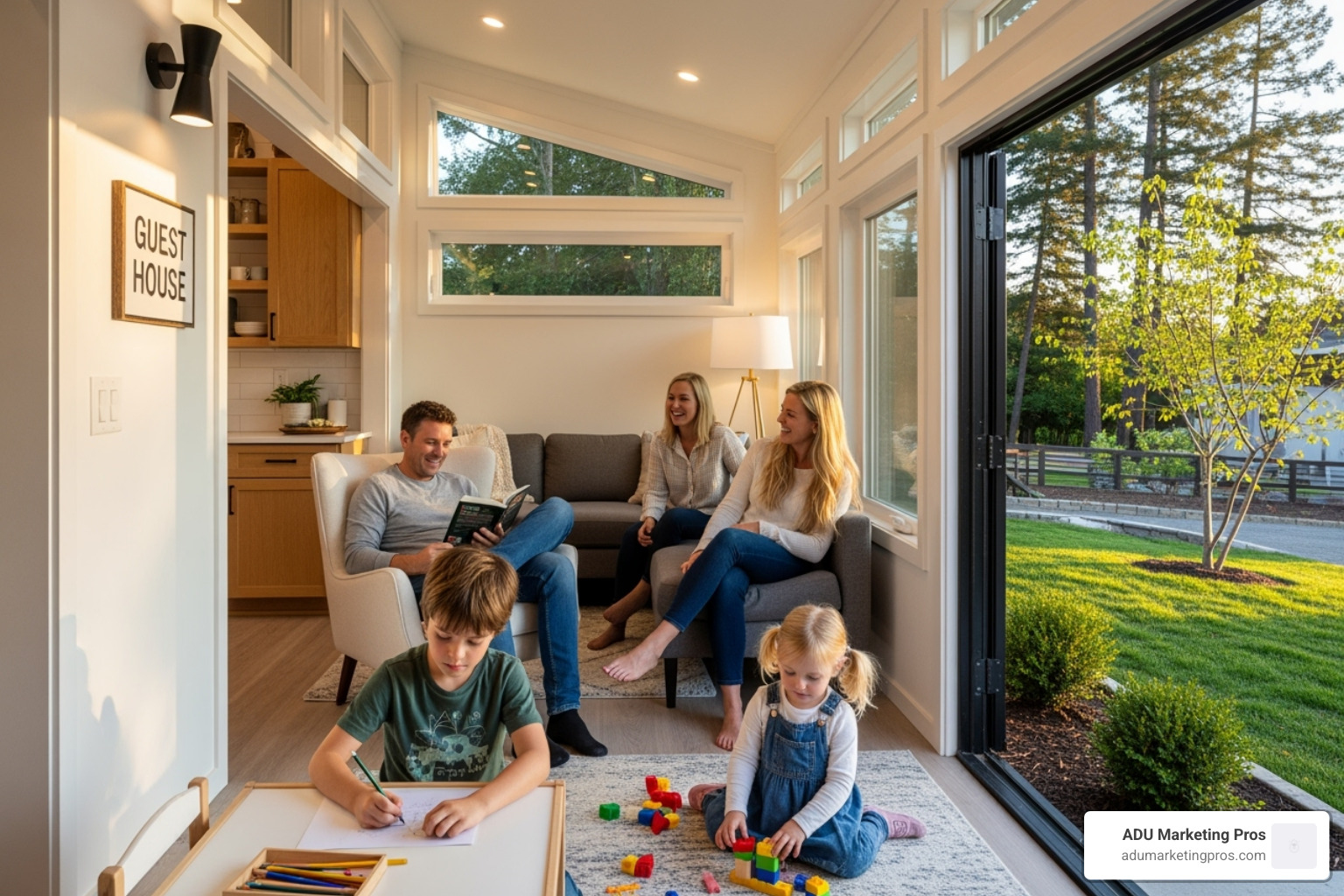
Calculating the ROI of a California ADU
The return on investment (ROI) for an ADU in California is exceptionally compelling, driven by high property values and strong rental demand.
- Property Value Increase: A well-designed ADU can boost your property value by 20% to 30%. On a $900,000 home, that’s an additional $180,000 to $270,000 in equity, often covering a significant portion of the construction cost immediately.
- Rental Income Potential: With California’s median rent around $2,850 per month, your ADU could generate over $34,000 annually. You can check current rates in your specific neighborhood on sites like Zillow’s California rental market trends.
- Example ROI Calculation:
- All-In ADU Cost: $350,000
- Annual Gross Rent: $2,850/mo x 12 = $34,200
- Annual Expenses (Taxes, Insurance, Maintenance @ 15%): $5,130
- Annual Net Income: $29,070
- Net ROI (Cash-on-Cash Return): $29,070 / $350,000 = 8.3%
This return significantly outperforms many traditional investments, all while building equity in your property.
- Example ROI Calculation:
- Multigenerational Living Savings: An ADU provides a dignified and independent living situation for aging parents or adult children. Compared to the average cost of assisted living in California (which can exceed $5,000/month or $60,000/year), a one-time ADU investment can save a family hundreds of thousands of dollars over several years.
- Home Office & Lifestyle Value: In a remote-work era, a separate, dedicated home office can improve productivity and work-life balance. It can also serve as a guest suite, creative studio, or pool house, adding immense flexibility to your daily life.
Making an Informed Decision
To decide if a prefab ADU is right for you, balance its distinct advantages against your specific needs, budget, and property limitations.
Key Advantages:
- Speed: Prefab ADUs can be designed, built, and installed in just 8-12 weeks after permits are approved, a fraction of the 6-12+ months required for site-built projects.
- Cost Predictability: The factory portion of the cost is fixed, significantly reducing the risk of budget overruns that can plague traditional construction.
- Reduced Disruption: The on-site work is compressed into a much shorter timeframe, minimizing noise, mess, and stress for your family and neighbors.
Important Considerations:
- Customization Limitations: While many finishes are customizable, the core floor plans and structural designs of prefab units are less flexible than a fully custom, site-built home.
- Site Challenges: Steep slopes, poor soil, or difficult backyard access can dramatically increase costs for any ADU project, but especially for prefabs that require large crane access.
- HOA Restrictions: While state law limits an HOA’s ability to prohibit ADUs, they can often still enforce rules regarding aesthetics, materials, and placement.
- Vetting Your Partner: Thoroughly vet prefab companies. Look for transparent, all-in pricing that clearly separates unit costs from site work and installation. Ask for references, review their warranty, and ensure they have experience navigating your local permit process. Always build a 10-15% contingency fund into your budget to cover any unexpected challenges. With careful planning, a prefab ADU is an excellent investment that offers immediate lifestyle benefits and long-term financial returns.
Conclusion: Your Path to a Successful Prefab ADU Project
After exploring the multifaceted prefab ADU California cost, it’s clear that a successful project hinges on understanding the total, all-in investment, not just the advertised sticker price. While the initial unit cost is a major component, it’s only one piece of a larger financial puzzle that includes design, permits, site preparation, foundation, utilities, delivery, and installation.
The total investment, typically ranging from $190,000 to over $450,000, reflects the reality of building in California’s high-cost market. However, the primary advantages of prefab construction—best speed and cost predictability—provide immense value. The ability to have a move-in-ready living space in a matter of weeks, not months, with far less disruption to your life, is a game-changer for many homeowners.
Smart budgeting is essential. Proactively accounting for “hidden” costs like utility trenching, crane rental, and permit fees—which can collectively add $50,000 to $100,000 or more—is the key to a financially sound project. The strategic value of this investment is undeniable. An ADU can generate tens of thousands in annual rental income, significantly boost your property value, and provide flexible, invaluable space for family, work, or guests.
For ADU builders and architects aiming to thrive in this competitive landscape, the challenge is to communicate this total value clearly. ADU Marketing Pros specializes in helping top-tier firms connect with informed homeowners, changing complex construction projects into successful, high-quality builds that meet and exceed client expectations.
Ready to explore your options further? Dive into our complete guide on ADU Modular Homes California for even more insights into making your ADU dreams a reality.

